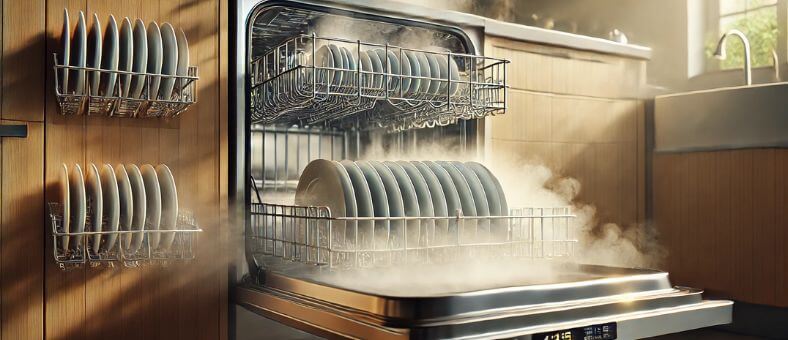Have you ever started your dishwasher only to find it chugging away hours later? You’re not the only one. The “dishwasher running for too long” issue isn’t just a one-off; it often signals deeper problems that compromise performance.
Dishwashers, essential in many homes, are resistant to glitches. If marathon cleaning sessions have become your dishwasher’s norm, you’re in the right spot. This guide uncovers reasons for such extended cycles and offers solutions to whip your appliance back into shape. Curious about the hold-up? Dive in and discover how to get your dishes spotless in no time!
Raise Those Brows! Costly Mistake!
If your dishwasher runs longer than it should, it can increase your energy bill by as much as 15%. Yes, those extra minutes really do cost you!
Table of Contents
Dishwasher Cycles and Their Run Times
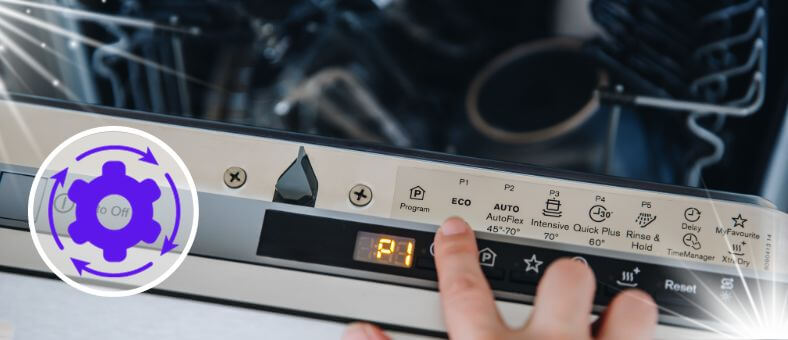
Alright, before we dive deep into the whys and hows of prolonged dishwasher run times, let’s get familiar with the basic cycles of a dishwasher and their typical durations. If you need a comprehensive breakdown on the topic, you might want to check out Dishwasher Cycles and Settings. This will give you a benchmark to judge whether your dishwasher is running too long or is just doing its thing.
Quick or Express Cycle
This is the go-to cycle if you’re in a hurry and your dishes aren’t heavily soiled. It usually takes about 20 to 30 minutes. But remember, it might not be as thorough as the longer cycles!
Normal or Standard Cycle
The most common choice, this cycle is designed to handle everyday dishwashing needs. It generally runs between 1 to 2 hours. It’s like the “balanced diet” of dishwasher cycles – not too short or long, just right!
Heavy or Pots & Pans Cycle
Got some filthy dishes or pots that have seen better days? This rigorous and thorough cycle typically runs for 2 to 3 hours. It’s the deep cleaning maestro for those stubborn stains and baked-on messes.
Eco or Energy-Saving Cycle
This cycle takes a more extended period, usually 2 to 2.5 hours, but uses less water and energy. It’s a choice for the environmentally conscious or those looking to save on utility bills.
Rinse Cycle
If you’re planning to run a full cycle later but want to give your dishes a quick rinse to prevent food from sticking, this short cycle, often lasting just 8 to 15 minutes, is your friend.
Cause 1: Sensor Malfunctions and Their Fixes
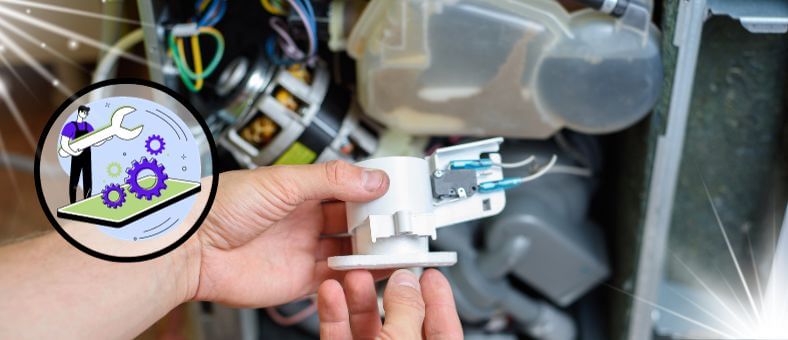
What Does the Sensor Do? Think of your dishwasher’s sensor as a diligent overseer, monitoring the cleanliness of the wash cycle. It’s designed to detect the level of dirt in the water and adjust the cycle length accordingly. A clean cycle continues until the sensor confirms the water is clear of debris, ensuring your dishes are spotlessly clean. However, if the sensor malfunctions, it may misread the water’s cleanliness, causing the dishwasher to run longer than necessary, even if the dishes are already clean.
Identifying Sensor Issues: You might suspect a sensor issue if your dishwasher seems to run indefinitely, especially when the dishes aren’t heavily soiled. This can indicate that the sensor is not accurately assessing the water’s cleanliness.
Effective Fixes for Sensor Troubles
- Clean the Sensor: Sometimes, all the sensor needs is a little TLC. Safely turn off and unplug your dishwasher, locate the sensor (typically at the bottom of the unit), and gently clean it with a soft cloth to remove any grime or buildup affecting its readings.
- Reset the Dishwasher: A reset can often refresh the system. Power down your dishwasher, wait a few minutes, then turn it back on to reset the sensor’s calibration.
- Consult a Professional: If cleaning and resetting don’t resolve the problem, it’s wise to call in a professional. A skilled technician can diagnose and repair deeper issues with the sensor, ensuring your dishwasher runs efficiently.
Cause 2: Overloading Mistakes – The Do’s and Don’ts
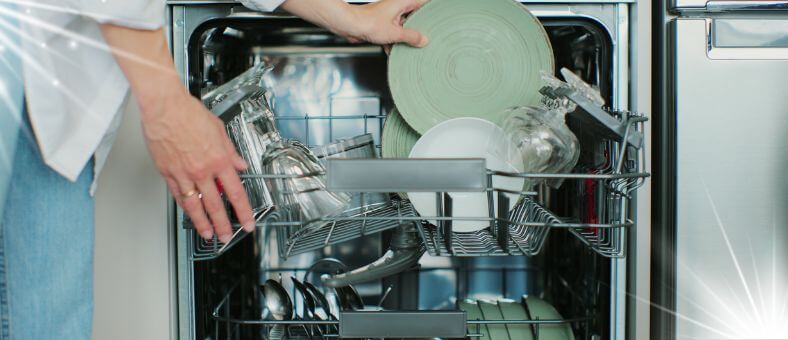
Understanding Overloading: In the rush of daily life, it’s tempting to pack as many dishes as possible into the dishwasher. However, overloading can cause longer cycle times and even result in poorly cleaned dishes. Why? When the dishwasher is overloaded, water and detergent can’t circulate freely, preventing thorough cleaning and requiring the machine to run longer to attempt to clean effectively.
Quick Fixes for Overloading
- Unload and Reload: If you notice signs of overloading, take some time to rearrange the dishes. This small effort can lead to significantly cleaner dishes and more efficient cycle times.
- Run a Rinse Cycle: If a full wash isn’t immediately necessary but the dishwasher is loaded, run a quick rinse cycle. This helps prevent food residues from hardening and makes the eventual wash much more effective.
Essential Loading Tips
Arrange Dishes Properly: Position plates on the bottom rack facing the center; glasses and lighter items go on top for optimal cleaning.
Avoid Blocking Jets: Keep large items from blocking water flow to ensure all dishes are reached.
Check the Manual: Follow your dishwasher’s manual for model-specific loading advice.
Cause 3: Clogged Filters – Cleaning Techniques for Efficiency
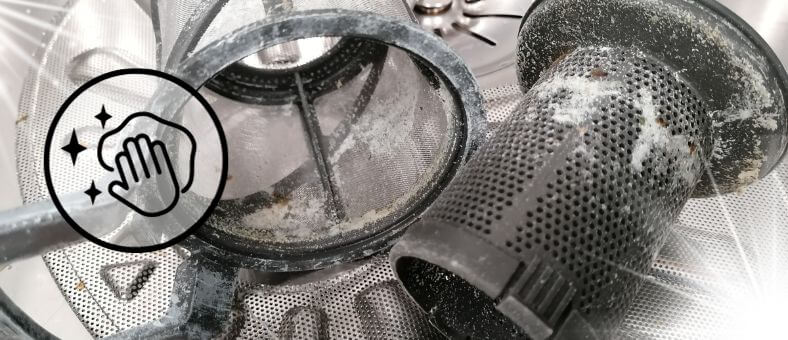
The Importance of a Clean Filter: Filters in dishwashers play a critical role by trapping food particles and debris. However, a clogged filter can significantly reduce your dishwasher’s efficiency. Not only does it prolong the wash cycle, but it also leaves dishes less than sparkling, as restricted water flow hampers proper cleaning.
Steps to Clean Your Dishwasher Filter
- First, ensure the dishwasher is turned off and unplugged for safety. Locate the filter, usually at the dishwasher’s bottom center.
- Gently twist the filter counterclockwise and lift it out. Rinse it under warm running water, using a soft brush to scrub away any stuck-on debris for a thorough clean.
- After cleaning, replace the filter in its slot. Turn it clockwise (or as directed by your model’s guidelines) until it is securely fastened.
Maintenance Pointer
Regularly checking and cleaning your filter – say, every month – can go a long way in maintaining your dishwasher’s efficiency.
Cause 4: Using the Wrong Detergent – Choosing Right
Did you know that the detergent you select can impact the length and effectiveness of your dishwasher cycles? Not all detergents are the same, and the wrong choice can lead to inefficient wash cycles.
Importance of Choosing the Correct Detergent: The appropriate detergent effectively breaks down food particles, facilitating smoother and quicker cycles. Conversely, using an unsuitable detergent might result in poor dissolution, extended wash times, and residue left on dishes.
Tips for Selecting the Right Detergent
- Consult the Manual: Always start by checking your dishwasher’s manual, which may recommend specific detergents best suited for your model.
- Consider Homemade Detergents: For those preferring natural or budget-friendly options, homemade detergents can be a great choice. Look up recipes and tips on creating detergents that are effective and gentle on the environment.
- Choose Between Powder, Liquid, or Pods: Pods offer convenience, but certain older dishwashers might achieve better results with powder or liquid forms. If you’re considering switching to pods or if you’re unsure how to optimize their use, it’s crucial to understand the specifics of your appliance.
- Avoid Overloading Detergent: More detergent doesn’t necessarily mean cleaner dishes. Overuse can actually leave a filmy residue. Ensure you’re using the right amount to avoid this issue.
Advice for Hard Water Areas
If you live in an area with hard water, consider detergents explicitly designed for such conditions. Hard water can cause a range of dishwasher problems, so using the right detergent can help prevent mineral build-up and keep your glasses streak-free.
Cause 5: Outdated Dishwasher Models – To Upgrade or Not?
Much like an aging car, dishwashers can show signs of wear after years of reliable service. But how can you tell if it’s genuinely time to upgrade or if the issues you’re encountering can still be fixed?
Why Age Matters: Dishwashers typically have a useful life of about 7-12 years. If your appliance is within or beyond this range and frequently experiences problems, it’s likely due to age.
Key Considerations for Upgrading Your Dishwasher
- Enhanced Efficiency: Modern dishwashers boast greater energy and water efficiency. Thanks to advanced sensors and new technologies, they not only reduce water usage but also lower electricity consumption, offering significant long-term savings.
- Repair Costs: Regular maintenance and repairs can become costly. If you frequently call for repairs, investing in a new dishwasher might be more economical in the long run.
- Advanced Features: Newer models come equipped with a plethora of features. Enhanced cycle options, superior drying techniques, and smart technology integrations are just a few upgrades that can make your dishwashing experience more efficient and convenient.
When Not to Upgrade
If your dishwasher is relatively young, or if it has sentimental value (hey, we’re not judging!) holds you back, consider getting a thorough check-up from a professional before deciding.
Cause 6: Stuck-in Heating Element – Solutions to Overcome
Understanding the Heating Element: The heating element’s primary function is maintaining the water at the optimal temperature for effective cleaning. If it fails to heat properly, your dishwasher may need extended cycles to achieve the necessary temperature for cleaning.
Identifying and Fixing a Malfunctioning Heating Element
- Dishes Aren’t Dry: If dishes remain wet after the cycle ends, this could signal a problem with the heating element.
- Visual Inspection: Before proceeding, ensure the dishwasher is turned off. Check the heating element for signs of damage, such as burn marks or warping, which could indicate it needs repair or replacement.
- Multimeter Test: For those familiar with DIY repairs, use a multimeter to check the heating element’s continuity. The lack of continuity suggests that the element needs replacing. If you decide to replace or install a new unit, follow a reliable guide or seek professional help.
- Consult a Professional: When in doubt, it’s advisable to call a professional technician. They can provide a precise diagnosis and ensure that any repairs or replacements are correctly performed, safeguarding your dishwasher’s functionality.
Cause 7: Delayed Start Feature – Ensuring Proper Settings

Ever discovered that the solution to a problem is simpler than you thought? It’s not always a mechanical issue causing delays with dishwashers—it might just be the Delayed Start feature.
Understanding the Delayed Start Feature: This feature allows you to program your dishwasher to start later, which can be handy if you want dishes cleaned by morning or prefer to run the dishwasher during off-peak hours to save on energy costs. However, if activated accidentally, it might appear as though your dishwasher has its own schedule.
Navigating the Delayed Start Feature
- Check Your Manual: Different brands and models have specific methods for setting the Delayed Start. Refer to your dishwasher’s manual for precise instructions.
- Look for the Indicator: Modern dishwashers typically feature a digital display or indicator lights. If you notice a timer symbol or a light labeled “Delay” or “Delayed Start,” this function might be activated.
- Resetting the Feature: There should be buttons to adjust or cancel the delay time. Press these until the delay indicators deactivate.
- Routine Settings Check: Before running your dishwasher, quickly review the settings to ensure the Delayed Start isn’t enabled unintentionally. This quick check can prevent unexpected delays and ensure your dishwasher runs according to schedule.
Bonus Tip
Some smart dishwashers might have mobile app integrations. If yours is one of them, ensure that the delayed start isn’t set from the app, especially if you share the app access with other family members.
Other Elements That Might Be to Blame
As we navigate the maze of dishwasher intricacies, we’ve touched upon several culprits that can extend those washing cycles. But, like any multifaceted machine, there can be other issues. If you find yourself scratching your head, you might need a detailed guide on troubleshooting and repair. In the meantime, here are a few more elements to consider:
Water Inlet Valve
This valve allows water to flow into the dishwasher. If it’s partially clogged or malfunctioning, the dishwasher might not fill efficiently, leading to longer cycles.
Door Latch
If the door isn’t latching properly, the dishwasher might not start promptly or frequently pause, sensing an ‘open door.’ Encountering issues with your dishwasher door unlocking during a cycle? Check out this comprehensive guide on Dishwasher Door Unlocking During A Cycle for solutions and insights.
Software Glitches
Just like your computer or smartphone, modern dishwashers with digital controls can face software hiccups. Sometimes, a simple reset can resolve this.
Worn-Out Motor
The motor propels the spray arm. If it’s wearing out, the washing process might be less efficient, extending the cycle duration.
Can You Stop a Dishwasher in the Middle of a Cycle?

Picture this: You’ve just started the dishwasher, and suddenly, you remember the forgotten mug on the counter. We’ve all been there! Can you halt the cycle and toss it in?
The short answer is, yes, you can. But let’s delve into the hows:
Pause Button
Most dishwashers have a ‘Pause’ or ‘Stop’ button. Press it, and wait a few moments. The machine should cease its operation.
Opening the Door
Once paused, gently open the dishwasher door. Some models automatically pause when the door is opened slightly. Always open with caution, as there might be hot steam inside.
Adding Items
Toss in that forgotten dish, close the door securely, and restart or resume the cycle.
Safety Note
Avoid abruptly opening the door without pausing, especially during the washing or rinsing phase. Sudden interruptions can sometimes confuse the dishwasher’s sensors.
Rapid Recommendation
Always ensure the door is latched properly after interruption. A secure latch ensures the dishwasher resumes its operation efficiently.
Proactive Maintenance: Tips to Prevent Prolonged Cycles
Let’s switch gears for a moment. Instead of constantly reacting to prolonged dishwasher cycles, how about we take a proactive approach? Just like you’d care for a prized car or a favorite gadget, regular maintenance of your dishwasher can prevent many issues from arising in the first place. So, let’s dive into some proactive tips to ensure your dishwasher runs in top shape, cycle after cycle.
Tip#1. Regular Filter Cleaning
We’ve touched upon this before, but it’s worth reiterating. Clean your dishwasher’s filter at least once a month. A clean filter means efficient water flow and fewer chances of extended cycles.
Tip#2. Inspect the Spray Arm
Over time, the holes in the spray arm can get clogged with debris. Periodically inspect and clean these holes using a soft brush or toothpick.
Tip#3. Run an Empty Cycle with Vinegar
Consider running an empty cycle with a cup of white vinegar on the bottom rack every couple of months. This natural cleaner can help break down grease and limescale, ensuring smooth operation.
Tip#4. Check the Water Inlet
Ensure that the water inlet isn’t kinked or blocked. Good water flow is essential for timely cycles.
Tip#5. Update Software
If your dishwasher is one of the smart ones with digital controls, ensure its software is current. Manufacturers sometimes release updates that fix bugs or enhance efficiency.
Tip#6. Don’t Forget the Seals
The rubber seals around the door ensure no water leaks. Wipe them down with a damp cloth regularly to prevent any build-up and to check for wear and tear.
Tip#7. Use the Right Amount of Detergent
We can’t stress this enough! More detergent doesn’t mean cleaner dishes. In fact, overusing can lead to longer rinse cycles and filmy residues.
Tip#8. Load It Right
Properly arranging dishes ensures that water circulates freely, cleaning everything effectively and efficiently.
Tip#9. Check for Wear and Tear
Regularly inspect internal components like the heating element, sensors, and motors. While they have a decent lifespan, knowing their condition can help you address issues before they snowball.
Tip#10. Consult the Manual
Your dishwasher’s manual isn’t just a boring booklet; it’s a treasure trove of specific maintenance tips tailored for your model. Please give it a read!
Final Thoughts: Dishwasher Running For Too Long?
We’ve journeyed through the land of prolonged cycles, and guess what? We’ve nailed down those tricky culprits. How exciting is that? From sneaky sensors to those forgotten settings, we’ve got them all in check.
Remember, every machine loves a little TLC, and your dishwasher is no exception. So, next time you’re faced with a plate pile-up, you’ll know how to get things sparkling quickly! And hey, if you’re considering upgrading or buying a new dishwasher, now’s the perfect chance. With all the knowledge you’ve gained, you’re set to make the best choice ever! Treat yourself and your kitchen to a fabulous, efficient cleaning buddy. Your dishes will thank you!
At WashDryDazzle, our primary goal is to equip you with invaluable knowledge to simplify your day-to-day tasks; to explore more, check out our central hub of Dishwasher Guides.
Frequently Asked Questions (FAQs)
What is the optimal run time for a standard dishwasher cycle?
The optimal run time for a standard dishwasher cycle, often called the “Normal” or “Standard” cycle, typically ranges from 1 to 2 hours. This duration ensures that dishes are thoroughly cleaned and rinsed. However, the exact time can vary based on the dishwasher’s brand, model, and the soil level of the dishes. Some modern dishwashers equipped with advanced sensors may adjust the cycle time according to how dirty the dishes are, ensuring efficiency and cleanliness.
Why is it essential to have timely dishwasher cycles?
Timely dishwasher cycles ensure that the dishwasher operates efficiently, conserving water and energy. They also help maximize the dishwasher’s lifespan and provide consistently clean dishes.
How do timely dishwasher cycles impact the longevity of the machine?
Regular and timely cycles ensure that the dishwasher’s components are well-rested, which can extend the machine’s lifespan. It also means less wear and tear on parts like the motor, pump, and heating.
How much water does a typical dishwasher use per cycle?
A standard dishwasher uses, on average, between 3 to 4.5 gallons (11 to 17 liters) of water per cycle. However, newer energy-efficient models can use as little as 2 to 3 gallons (7.5 to 11 liters) per cycle. It’s always a good idea to consult your dishwasher’s manual for specific water usage information for your particular model.
Can a dishwasher be more water-efficient than washing dishes by hand?
Yes, using a dishwasher can often be more water-efficient than washing dishes by hand. Hand-washing dishes can use up to 27 gallons (102 liters) of water, whereas a dishwasher, especially modern energy-efficient models, can use a fraction. Additionally, dishwashers utilize water at a higher temperature, which can be more effective at cleaning and sanitizing dishes.





